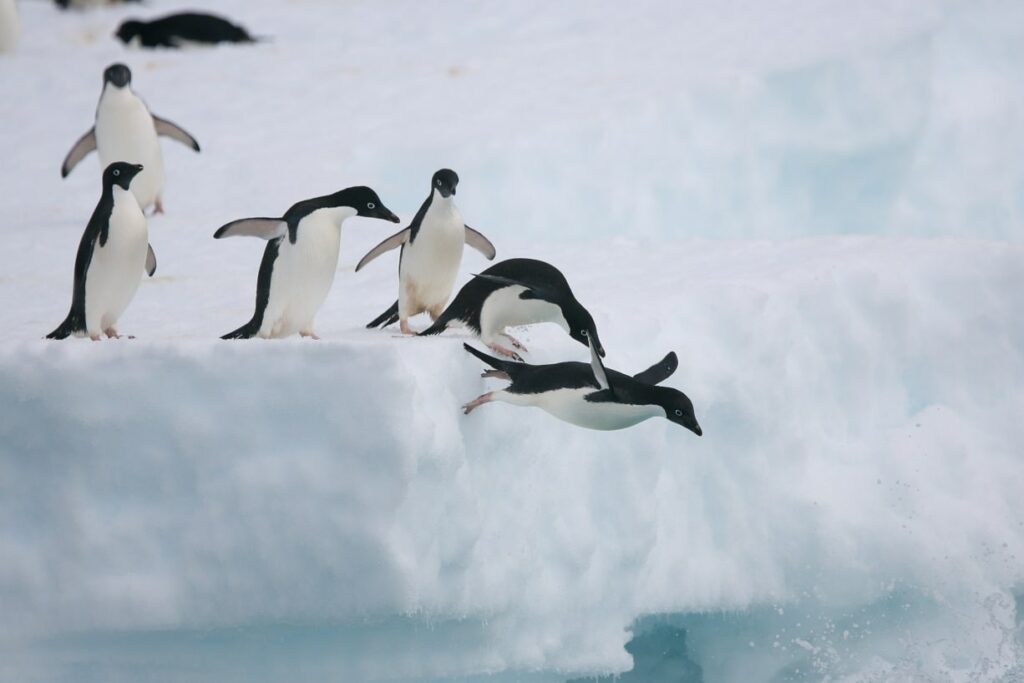Penguins have a notorious body shape and counter-shaded color pattern recognized by people worldwide. They have long paddle-like wings and streamlined, fusiform, potato-shaped bodies, where the ends of the body are not as wide as the middle.
A penguin’s neck is short compared to its large head, and its tail is stiff and shaped like a wedge. Unlike most birds, penguins stand upright on land, with their head over the neck, body, and feet.
When looking at a penguin, it becomes clear that penguins are incapable of flying through the air. Their wings are too small to lift their bodies off the ground, and their short legs would never allow them to get a running start.
However, penguins can soar underwater. Their bodies are perfectly adapted for swimming. Anyone who has watched penguins swimming might consider their incredible underwater movements and acrobatics as a form of flight, albeit in water instead of in the air.
Many penguins can swim faster by launching themselves out of the water. This behavior, called porpoising, helps them evade predators chasing them. They can travel faster through the air than water, so leaping in and out allows them to escape predation quickly.
Why Can’t Penguins Fly?
Penguins have become expert swimmers during the last 60 million years of their evolution. The traits to be excellent swimmers are different than those required to be fliers. As a result, penguins traded the ability to fly for the ability to swim well.
Their wing bones fused and became more paddle-like, and their bone density increased to make them less buoyant. These traits allow them to dive deeper to chase after prey and access available food sources.
Scientists have found fossils of many extinct penguin species, including some penguins that grew to be the size of humans. However, none of the fossils are from penguins that could fly. Researchers still haven’t found fossils from the penguin ancestors that could fly.

Also Read: Can Peacocks Fly
How Far Can Penguins Swim?
While penguins cannot fly, they are capable of making incredible swims. Some species cover as much as forty miles (64 kilometers) daily while roaming and foraging in the ocean.
Larger species, such as the Emperor and King penguins, may travel more than a thousand miles (1,609 kilometers) over a couple of months while foraging for food.
Adelie Penguins may travel more than three thousand miles (4,828 kilometers) and then return to their nesting grounds at the start of the breeding season.
Some penguin species migrate long distances from breeding grounds to other areas, although research hasn’t yet identified the advantage of these trips.
Food resources are plentiful in the waters close to the breeding areas, but many penguins swim long distances from the breeding grounds after raising their young. They return later to their breeding grounds the following year.
How Deep Can Penguins Swim?
Many penguins usually forage for food in relatively shallow waters, reaching depths around 50 to 300 feet (15 to 91 meters). These birds can find plenty of fish to forage at these depths and do not need to stay underwater for more than ten minutes.
Researchers have found that some species can dive to depths of 1,100 feet (335 meters) for King Penguins and nearly 1,800 feet (548 meters) for Emperor Penguins. When penguins dive that deep, they may stay underwater for more than twenty minutes.
How Fast Can Penguins Swim?
Because penguins have evolved to have the most efficient streamlined bodies for swimming, they can swim fast.
Larger penguin species, such as Emperor and King penguins, can swim as fast as 10 miles per hour (16 kilometers per hour), while smaller species usually swim around 5 miles per hour (8 kilometers per hour).
Penguins can swim much faster when they chase prey or try to escape predation. Depending on the penguin species, they can reach speeds between 15 and 25 miles per hour (24 to 40 kilometers per hour).
When Do Baby Penguins Start Swimming?
Most Antarctic penguins return to the same rookery every year to breed, usually the same rookery where they hatched. Penguins that live further north in a temperate climate nest underground, under bushes, or among tree roots, depending on the available habitat.
The incubation time varies among species, ranging from one month for small species to more than two months for larger species.
Baby penguins among the different species also start swimming at various times after hatching. Chicks from the smaller penguin species start swimming sooner than chicks from the larger species. Baby penguins swim once they shed their down and their juvenile feathers grow.
Fledging can take seven weeks for Adelie Penguin chicks, while other species take far longer. King Penguin chicks don’t fledge until they are around thirteen months old. The juvenile plumage of penguins is waterproof, similar to adult feathers.
Once the juvenile feathers have grown, penguin chicks can become independent. In some species, like the Gentoo Penguins, fledged penguins will continue to receive parental care after fledging but ultimately leave the colony within a couple of weeks.
Also Read:
What is a Group of Penguins Called
Where Do Penguins Live
